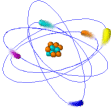Tissue as a Self-organizing
System
with Fractal Dynamics
Waliszewski P, Konarski J.
Department of Theoretical Chemistry, University of
Poznan, Poland.
Cell is a supramolecular dynamic network. Screening
of tissue-specific cDNA library and results of Relative RT-PCR indicate
that the relationship between genotype, (i.e., dynamic network of
genes and their protein regulatory elements) and phenotype is non-bijective,
and mendelian inheritance is a special case only. This implies non-linearity,
complexity, and quasi-determinism, (i.e., co-existence of deterministic
and non-deterministic events) of dynamic cellular network; prerequisite
conditions for the existence of fractal structure.
Indeed, the box counting method reveals that morphological
patterns of the higher order, such as gland-like structures or populations
of differentiating cancer cells possess fractal dimension and self-similarity.
Since fractal space is not filled out randomly, a variety of morphological
patterns of functional states arises. The expansion coefficient characterizes
evolution of fractal dynamics.
The coefficient indicates what kind of interactions
occurs between cells, and how far from the limiting integer dimension
of the Euclidean space the expanding population of cells is. We conclude
that cellular phenomena occur in the fractal space; aggregation of
cells is a supracollective phenomenon (expansion coefficient >
0), and differentiation is a collective one (expansion coefficient
< 0). Fractal dimension or self-similarity are lost during tumor
progression.
The existence of fractal structure in a complex tissue
system denotes that dynamic cellular phenomena generate an attractor
with the appropriate organization of space-time. And vice versa, this
attractor sets up physical limits for cellular phenomena during their
interactions with various fields.
This relationship can help to understand the emergence
of extraterrestial forms of life. Although those forms can be composed
of non-carbon molecules, fractal structure appears to be the common
feature of all interactive biosystems.
c2001 COSPAR. Published by Elsevier Science Ltd. All
rights reserved.



